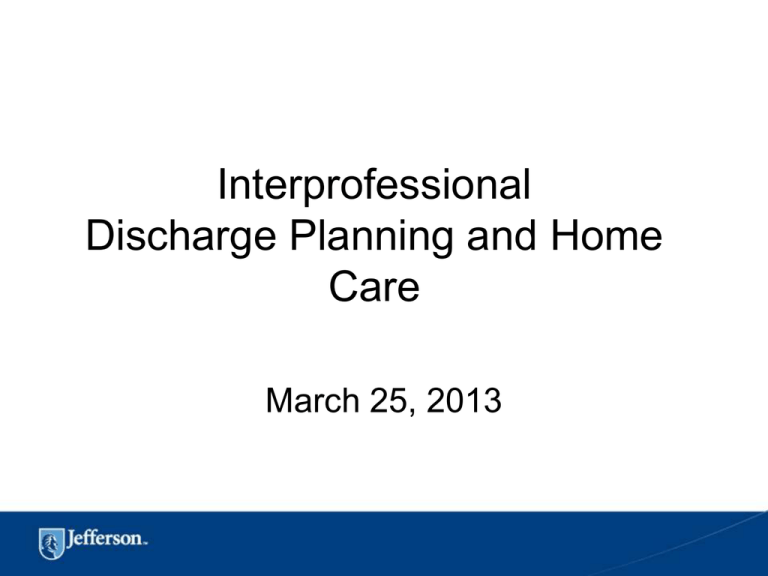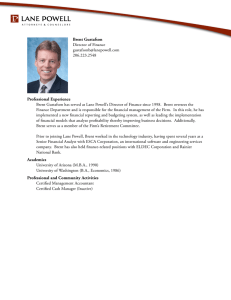Interprofessional Discharge Planning and Home Care
advertisement

Interprofessional Discharge Planning and Home Care March 25, 2013 Welcome and Introductions Faculty • Nursing – – – – Karen Alexander, MSN, RN Mary T. Bouchaud, PhD, RN, MSN Maria Marinelli, MSN, CNOR, RNFA Elizabeth Speakman, EdD, RN, CDE, ANEF (JCIPE) • Radiologic Sciences – – – – Colleen Dempsey, MS, RT(R) Frances Gilman, DHSc,RT(R)(CT)(MR)(CV) Christina Truluck, PhD, CNMT, RT(N) Richard Weening, PhD, RT(R)(CT)(MR) • JCIPE – Reena Antony, MPH, BSN Welcome and Introductions Students • Radiologic Sciences – – – – – Radiography Nuclear Medicine MRI CT Radiation Therapy • Nursing Session Schedule Time Activity Location 8:00am – 8:05am Complete the pre-test (Nursing > Ipads, Rad Science > Hard Copy Survey) Brent Auditorium 8:05am – 9:10am Welcome and Module Overview Brent Auditorium 9:10am – 9:20am BREAK Faculty and students will go to assigned classrooms Location 1: Brent Auditorium Location 2: 207 JAH Location 3: 307 JAH 9:20am – 9:45am Small Group Activity Location 1: Brent Auditorium Location 2: 207 JAH Location 3: 307 JAH 9:45am – 9:50am Faculty and students in 207/307 JAH return to Brent Auditorium Brent Auditorium 9:50am -10:10am Large Group Discussion Brent Auditorium 10:10am – 11:25am Presentation by Rad Sciences and Nursing Faculty Brent Auditorium 11:25am – 11:45am Q&A Brent Auditorium 11:20am -11:30am Complete session evaluation Brent Auditorium Objectives At the end of the session, participants will be able to: 1. Value the roles of specific health professionals in the environments other than the hospital setting. 2. Develop a plan of care for a case scenario. 3. Discuss benefits and challenges of interprofessional care in home and hospital settings. 4. Identify strategies to improve interprofessional care. Part I. Overview and Video • Overview of Interprofessional Discharge Planning and Home Visiting Module • Viewing a video depiction of 4 professions involved in home care setting • Discussion of other professions’ roles Why is this important (if I will only be practicing in the hospital)? • The Joint Commission incorporated “handoff communication” in their 2008 National Patient Safety Goals. • We often don’t think of the transfer from hospital to home as a “hand-off”, but it is. • We can assist with making the “hand-off” from hospital to home efficient and safe through comprehensive discharge planning. Importance of hospital to home and home to hospital “hand-offs” • One study showed that nearly 1 in 5 patients discharged from the hospital to home suffered an “adverse event” ranging from diarrhea from medication, falls resulting in fractures, infections, and others. • There is a need for medical information to be communicated to the primary physician and to the home care agency. What can we do? • Be aware of “teachable moments” so that your patients and family will have a good knowledge and skill base. • Listen to your patients and family to improve their ability to function optimally when they return home. • Allow your patient and family to participate in their care. What can we do? • Participate in discharge planning so that all are aware of the typical living situation that your patient will face at home. • Be aware of regulations and reimbursements that may affect home care (does your patient’s insurance include home infusion, for example?) • Use SBAR or other effective communication techniques. • Others? Video http://jeffline.jefferson.edu/jcipe/learning/ho me_visit/ Response to video • Positive interactions? • Interactions that could be improved? • Other professions who could be involved? References Baxter, P. & Markel-Reid, M. (2009). An interprofessional team approach to fall prevention for older home care clients ‘at risk’ of falling: health care providers share their experiences. International Journal of Integrated Care, 9, 1-12. Crossen-Sills, J et al. (2007). Home care today: Showcasing interdisciplinary management in home care. Home Healthcare Nurse, 25(4), 245-252. Dailey, M (2005). Interdisciplinary collaboration: Essential for improved wound care outcomes and wound prevention in home care. Home Health Care Management and Practice, 17(3), 213-221. Hohl, D. (2009). Transitions in home care. Home Healthcare Nurse, 27(8), 499-502. Part II. Small Group Exercise Break and Small Group Exercise • Location 1: Brent Auditorium – Faculty: Karen Alexander, Colleen Dempsey, Frances Gilman • Location 2*: 207 College – Faculty: Maria Marinelli, Christina Truluck, Reena Antony • Location 3*: 307 College – Faculty: Mary Bouchaud, Richard Weening *Remember to come back to Brent Auditorium by 9:50am for the large group discussion) Part III. Faculty Presentations • Faculty Presentations – MRI Safety Faculty: Richard Weening, PhD, RT(R)(CT)(MR) – Radiation Therapy (Medical & Airport Scanners) • Faculty: Colleen Dempsey, MS, RT(R) – Radiation Pharmaceuticals • Faculty: Christine Truluck, PhD, CNMT, RT(N) – Nurse’s Role / Collaboration with Rad Sciences Professionals • Faculty: Maria Marinelli, MSN, CNOR, RNFA – Nurse’s Role in the Community/Patient-Centered Medical Home • Faculty: Mary Bouchaud, PhD, RN, MSN • Question and Answer Period with Faculty Panel Session Evaluation

